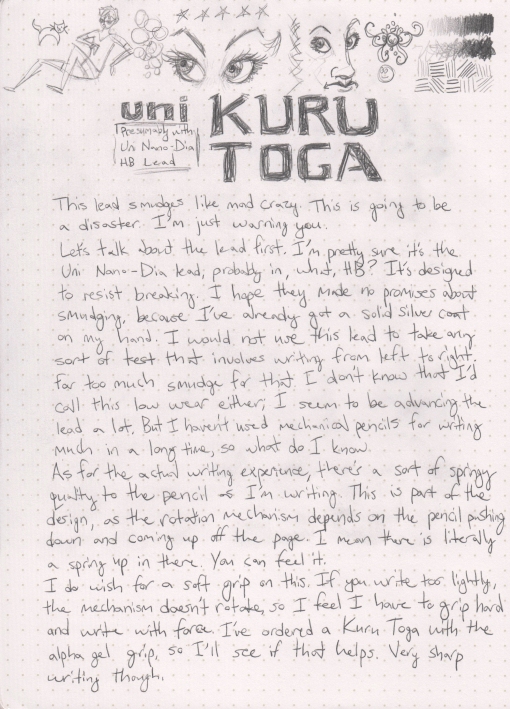
For once, the smudges on the page are ACTUAL product-produced smudges, and not the result of using a series of abominably crappy scanners. But the paper appearing a slightly pinkish hue? I HAVE NO IDEA.
Brad, now at JetPens, generously arranged for JetPens to send me a Jiffylite envelope cushioning samples of pure wonder and delight in writing utensil form. It is taking all my willpower to avoid typing this information in all caps, and to refrain from typing this face— :D —dozens of times. Oh heck, we’ll let loose for one sentence. THANK YOU BRAD AND JETPENS!!!!!! :D :D :D Those faces count as punctuation on that sentence.

This is a pencil. Not a pen. I am going to want to refer to it as a pen, because that is all I have reviewed, but stop me. It is a PENCIL.
Before I can get into a review of the Kuru Toga, I’ve got to point you toward some of the great reviews that came before me. Go read these and then come back. I’ll wait for you here.
OfficeSupplyGeek Kuru Toga review
Dave’s Mechanical Pencils Kuru Toga review
Everything I know about this pencil (aside from my own experience with it) has come from reading those reviews (which is why I linked you to them, rather than awkwardly trying to summarize what’s already been well written, seeming as though I came by such knowledge all on my own), and from JetPens’ own description of the Kuru Toga engine:
“The Kuru Toga, on the other hand, has a core rotation mechanism that continually rotates the pencil lead as you write. The lead is twisted through a spring-loaded clutch, it works by twisting incrementally every time you lift the pencil up (i.e. during printing words, etc). This allows a uniform wearing of the pencil lead so that it always remains as a pointed tip. Not only does it solve the above problems, but it also gives you an amazingly thin line. You are effectively using only 50% of the lead area that you were previously using with your old mechanical pencil. Thus, a 0.3 mm Kuru Toga will write incredibly thin lines and have less breakage than a standard 0.3 mm mechanical pencil.”
This is not JUST a mechanical pencil; it’s innovation in a barrel. Don’t forget that. I like seeing products where the makers have pushed the boundaries, have gone above and beyond what’s strictly necessary into the realm of what’s potentially extraordinary. Even if this pencil were a complete disaster, I’d still be excited about it for that reason alone. It shows vision.
From the grip up, the Kuru Toga isn’t anything particularly remarkable. A small, translucent, smoky black plastic cap (not pictured, oops) makes a nice little click to securely cover the eraser (I’ll miss this cap, when I inevitably lose it). The eraser, while not as big as those on wooden pencils, is at least not the smallest thing I’ve found on the end of a pencil, and erases well. The grey branding on the clip goes nicely with the silver-grey barrel. I don’t know how secure the clip is, but I have an instinctive distrust of all plastic clips, having dislocated many in my youth. All the fun of the Kuru Toga, of course, is on the other end.

Office meeting on the top, PARTY ON THE GRIP. Wait, why would I obliquely compare this wonderful pencil to a mullet? Mullets are terrible. This pencil is fantastic. Shame on me.
The light-grey see-through grip gives you an excellent view of the Kuru Toga engine in action. If you push your finger on and off the tip of the pencil repeatedly, you can see the yellow part turning around and around. You can also see how much pressure it takes to get the engine turning; too light of a touch will fail to make the mechanism turn, which could be a problem if you write lightly.
The tip, I believe, is all metal (or at least, it tastes like metal), which I find pretty visually appealing, though it might look better if the clip and the tip were the same color (either both white, or both metal). There’s also a little rubber ring around the metal tip, toward the top. It looks neat, but I find it a little confusing, being so small. I guess you just line that up to be the point of contact between the pencil and the finger you rest your pencil on? But if you grip higher, then that ring is of no use to you at all. I just want to know what the thought process was when including that in the design. I’m also torn between the aesthetic appeal of having the Kuru Toga engine components visible, versus the desire I often had for a cushiony grip on this pencil. If you’re making your marks too lightly, the engine doesn’t rotate, so I felt I had to write with a little more force than I might have otherwise used, which led to me gripping the pencil a little bit harder than was strictly comfortable for a long writing session. And the pencil itself provides almost no weight to help with this; being almost entirely plastic (including the Kuru Toga engine), it’s a very lightweight pencil. A lightweight pencil feels nice, but I think having more weight in the pencil itself might be helpful in terms of making the rotation process a little easier for lighter writers.
So how did it write? First, I wanted to replicate OfficeSupplyGeek’s findings by filling out a crossword with the Kuru Toga and comparing it to the same crossword filled out with a non-rotating mechanical pencil (since the only other 0.3mm pencil I have was Muji’s hexagonal mechanical pencil, that’s what I used). I am terrible at crosswords, so I also just copied down the answers from the solved puzzle from the first website I found that would actually print the crossword out, instead of just printing out all the clues and no crossword table.
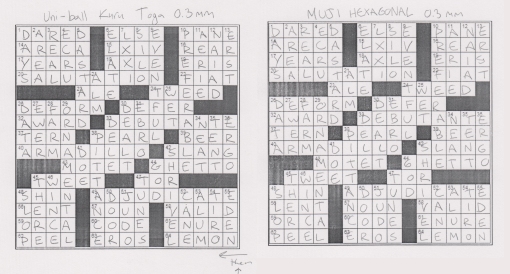
Kuru Toga on the left, non-rotational on the right. Since I'm left-handed (a.k.a. smudge-handed), I filled out these puzzles starting at the bottom right, working my way leftward, then going up to the next row and repeat.
In hindsight, I should have made sure to use the same brand of lead in both pencils, starting from a fresh piece of lead, but I just used the lead that each pencil came with. For the Kuru Toga, I think that’s Uni’s NanoDia HB lead. For the Muji, I have no idea, because as a rule they brand nothing. Presumably it’s also HB.

Kuru Toga on top, non-rotational on bottom. Order of letters written: N-O-M-E-L for the first word, D-E-R-A-D for the last word. The N and D in the middle is a side-by-side comparison of the first letter written against the last letter written. Click for a closer examination.
Ignoring the fact that the lead in the Kuru Toga wrote darker overall, you can see that there’s no difference in the sharpness between the first letter written and the last letter written. In the non-rotational pencil, the D is palpably wider than the N; I kept the pencils still in my hand when writing (no habitual rotation of pencil in hand) to make sure this is just a comparison of normal lead wear. The crossword puzzle was the first writing test; let’s look at the lead.
Kuru Toga’s on the right, but the leads look almost identical. I think the difference here was made by the fact that the sharp side point was kept rotating around, instead of having that flat plane continuously in contact with the paper, as was the case with our non-rotational friend on the left. So then I did a drawing test; unlike writing, drawing involves way more variation in weight of the lines you make and the amount you press the pencil to the page.
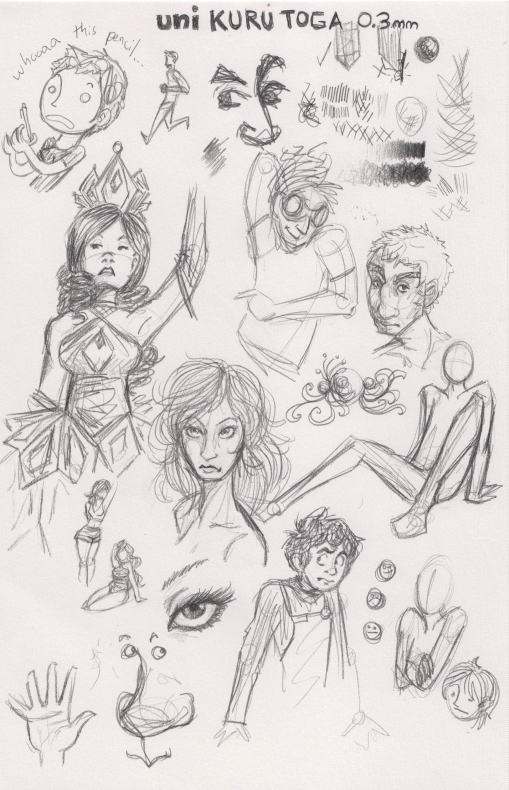
"Oh, I can use a pencil with an eraser! Now I can prove I actually know how to draw!" Proceed to not do that, barely use eraser, and not finish drawing bothersome things like hands.
The Kuru Toga does well for drawing, though it takes a bit to get used to the springy quality that’s integral to the function of the turning mechanism. It almost feels a little unstable when drawing at first. “THE TIP MOVES OH CRAP THE PENCIL IS COLLAPSING I BROKE IT” may be one of your first thoughts, if you’ve never used one of these pencils before and don’t know what you’re getting into (which is exactly what happened with my first Kuru Toga last year, 0.5mm). It’s just something you have to get used to.
I’m surprised to note that, at no time was I ever worried by working with such a thin lead. In spite of the springiness, the lead never felt fragile; I was never worried about making heavy marks. It’s a weird combination. The lead felt totally secure, and yet the springiness made the pencil feel a little odd. Not as noticeable when writing, but something about drawing really made me realize that yes, there is a spring in this pencil, and that spring is necessary to rotate the lead. Now, the lead the Kuru Toga came with, well…
I will want to find a different lead for this pencil, or I’ll want to learn to do all my writing from right to left. This was after doing the writing sample at the very top (remember the top? Feels so far away) of this review, where I did not work from right to left like I did with the crosswords or the drawings. Back to the drawings; how did the lead look after the drawings, my second Kuru Toga use exercise?

The end of the lead almost looks like this: > instead of like this: 7 HOORAY! Click to gaze more closely at the leadly depths.
Starting to achieve that advertised ideal! But would it last? Let’s see how the lead looked after my third Kuru Toga exercise (the writing sample at the top):
Well, it’s got a bit of a lean again. But I don’t think the lean affected the performance; writing was sharp from beginning to end. My guess is that the lead is, more often than not, off from the ideal symmetrically pointed shape, but the constant rotation still keeps your writing looking fairly sharp. If there are any unsavory broad sides developing on the lead, you don’t write with them long; every lift of the pencil rotates that surface, changes it a little. And I didn’t have any breaking of the lead, not at the tip, nor further up the shaft. I do remember in days of old having the very sharp and pointed tips of my mechanical pencil leads break a little, leaving a dark point surrounded by little lead crumbs on the page. Never had that happen with the Kuru Toga.
Great, affordable, creative, and innovative mechanical pencil. I’ve also started to see the 0.5mm version of this pen in big box stores (but not at as good of a price as JetPens), so this isn’t some totally isolated-from-mainstream-America product. If you want to stop having to rotate the pencil yourself to keep a sharp point available, the Kuru Toga HAS GOT IT GOIN ON, YO.
Thanks again to JetPens and Brad! :)
Uni-ball Kuru Toga Auto Lead Rotation Mechanical Pencil – 0.3 mm – Silver Body at JetPens

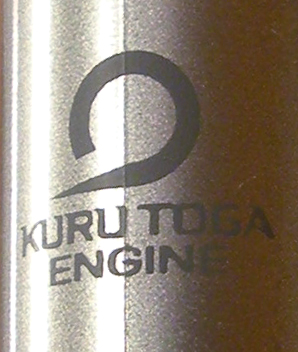
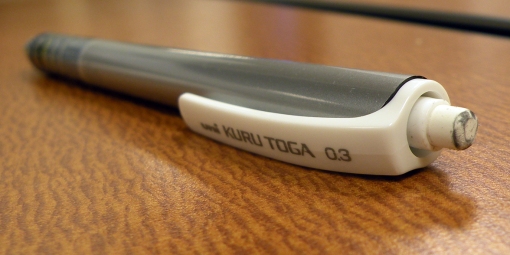


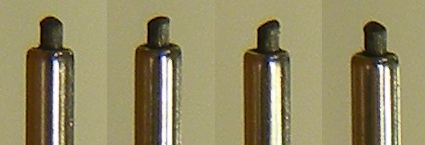
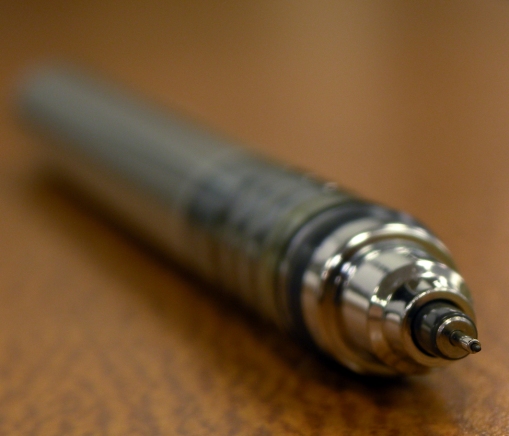
Awesome review! Now I need to figure out what is the best lead for lefties. :)
That would be great! Then I could have a standard lead for reviewing pencils…otherwise I end up judging both the pencil and the lead, instead of just the pencil. Gotta review one at a time!
Wow, you were very thorough in picking apart the look and performance of this excellent pencil. I have the .5, but the .3 looks very desirable. If only it had a retractable tip or some sort of cover for the metal sleeve – then it would be the ultimate, at least for me.
Great job on this review.
Thanks! :) Yeah, a retractable tip would be nice, especially on a pencil as sharp as this. I’m sure it’ll poke/stab/rip through some pockets and bags eventually
I have the green 0.5 mm version—the little cap covering the eraser is green in the same way that the grey one has a grey cap. I hadn’t noticed the rubber ring near the tip at all, as my grip seems to end up over the orangey bits of the mechanism. It’s green on the green pencil.
I actually bought this pencil for doing crosswords, as that’s pretty much the only thing I do in pencil these days. With the rotating tip, it’s actually maybe a bit too sharp when used on newsprint (which is, after all, pretty crappy paper).
Later I bought one of the fancier versions which is at least half-again thicker than the standard version. It also has a squishy rubber grip and is much more tip heavy than the standard pencil—maybe the mechanism is all metal or something.
This pencil seems like it would be great for taking notes, especially if you have a writing style that involves a lot of pen lifts (giving the mechanism a chance to rotate the lead). Say, if you were writing in Chinese or Japanese. These days, my writing style seems to be much more about dragging the point around in circles and not lifting it as frequently, so it’s not as good a match for me as I might have hoped. The idea is really cool, though.
I got one of these pencils today, and I like it a lot. One thing I’m trying to figure out, though, is how I add new lead to it. Can you tell me where it goes?
Sorry, hit Return too soon.
I see there’s a tiny hole under the eraser; I don’t have any 0.5 mm leads to try, but do you have to slide them in there, one at a time?
Yeah, or as many as you can get to go in at once :) They should come with a piece of Uni’s NanoDia lead…but my lefty experience finds the NanoDia a bit too smudgy….I should really get on figuring out what leads are good for a lefty to use…perhaps the Pentel Ain Stein lead…
I know this is an older post, but did you ever find a good lead for lefties? I’ve been using Pentel HB for work and it’s way too soft. I think I used to use the 2H for art, but it’s been a while. I want to get back into drawing, and need to figure out what lead would be good to buy…
[…] and a Signo DX in one sharp looking pen ….AT THE SAME TIME! The only thing missing is a Kuru Toga component (if only such were possible); that alone would make the Style Fit an instrument of utter […]
[…] of exceptional dimensions you’ll find the most fantastic little innovation this side of the Kuru Toga. According to JetPens, ‘OLNO’ is a play on the Japanese word “oru”, or to […]
[…] all going to work about the same when it comes to standard mechanical pencils. There are rare, exceptional cases, but for the most part the pencil will be judged on aesthetics and comfort, with writing sample […]
The springiness is something my wife looks for in a mechanical pencil–it helps keep the lead from breaking. This would be the 2nd one we know of that has that feature. I’ll try to find out what the other one is.
[…] Mechanical Pencil: Uni Kuru Toga […]
[…] Heather! Let me tell you about the Kuru Toga, and how I’ve seen it everywhere now from Wal-Mart to […]
[…] since the Kuru Toga came into my life, I haven’t tended to give much thought to mechanical pencils. But the Pentel […]
[…] in the clip. The only improvement I’d like to see here is for Uni to find a way to shrink the Kuru Toga mechanism into the size of a multi pen refill. A multi pen made of Jetstreams and a Kuru Toga would […]
[…] 0.5mm Uni Kuru Toga with extra lead and extra […]